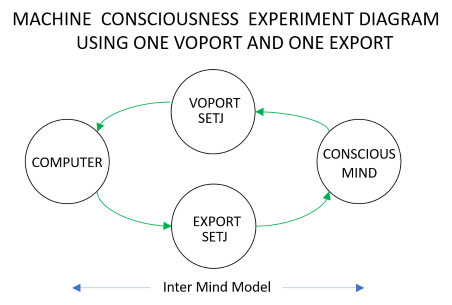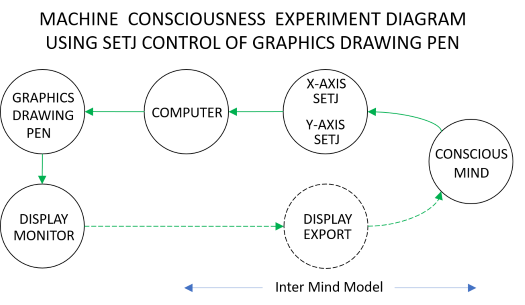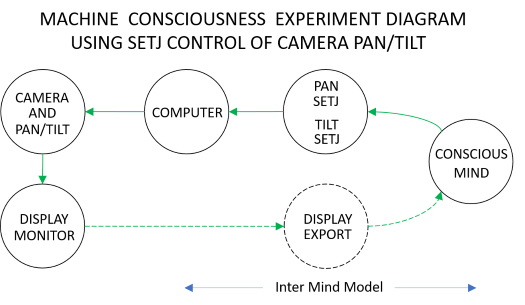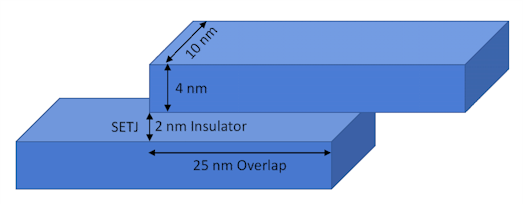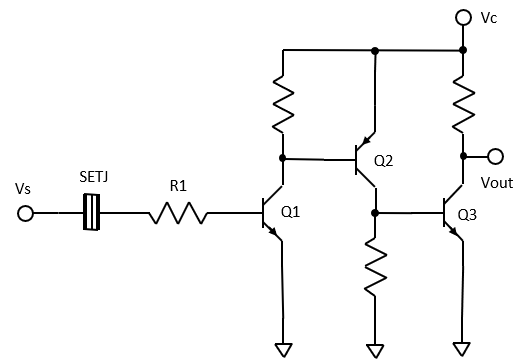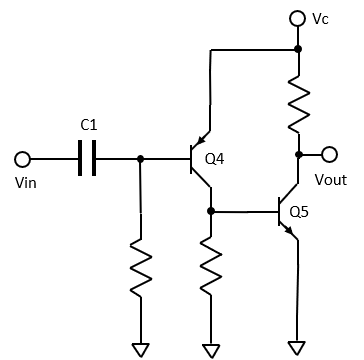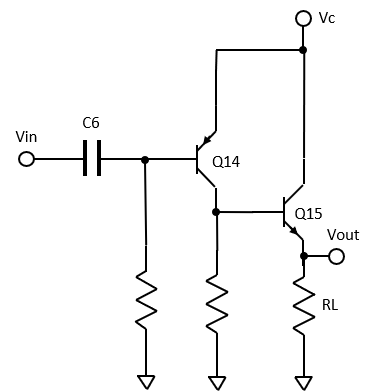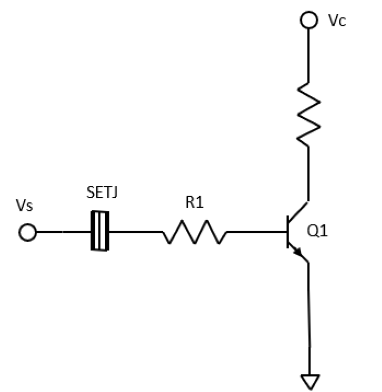|
Machine Consciousness Experiment Using Single Electron Tunneling Junctions Move pointer over Acronyms to see Meanings CONTENTS:
Neural Spike Train Model And A New Technology
Minimal Experiment Configuration Using A Real ExPort
Experiment Configurations Using Free ExPorts
Ultimate Experiment Configuration
VoPort And ExPort Arrangements
Why We Should Want To Do This Experiment
IntroductionWelcome to the phase three Machine Consciousness Experiment description document. This Experiment is motivated by concepts from The Inter Mind website and especially by concepts from the Inter Mind Model subsection. It is unknown exactly what kind of Electronics and configuration of Electronics will act as an Inter Mind (IM) to Bridge the Gap between a Physical Mind (PM) and a Conscious Mind (CM). The Configurations and Circuits described below are necessarily first concept designs that will mature over time. The exciting aspect of this is that it is even conceivable.
The unknowableness of how to design an Artificial Inter Mind is a little like the story of Thomas Edison inventing the Light Bulb. He did not know what the right material would be that would glow without burning out. He could not know if it was even possible, but he persevered. He had to steadfastly run Experiment failure after Experiment failure using different materials before finally succeeding. There is a myth that says he tried 1000 times before succeeding.
The magnitude of difficulty for the task ahead should not be underestimated. I believe it is going to take many chip level designs and many Experiments in order to ultimately succeed with this project. We should persevere while steadfastly designing various kinds of Electronics, using different configurations and arrangements of that Electronics, until we succeed.
Eenie Meenie, Chili Beanie, The Spirits Are About To Speak ...
Experiment BackgroundThe Inter Mind Model (IMM) separates the Mind into three functional components. The first component is the Physical Mind (PM) which corresponds to the Brain and exists in Physical Space (PSp). The second component is the Conscious Mind (CM) which does not correspond to anything in PSp. Instead, the CM exists in a separate Conscious Space (CSp) which we do not fully understand yet. We can only suspect that it exists because we cannot explain things like the Experience of the color Red, for example, with PSp explanations and concepts.
The two things we do know about the experience of the color Red is that when Red is being perceived by the Mind, 1) certain Neurons fire in the the PM, and 2) the color Red is Experienced in the CM. No one can explain how we get from Neurons firing to the Experience of Red. So, it is logical to propose some sort of Inter Mind (IM) that performs the interface function between the PM and the CM. The IM probably exists in PSp and also in CSp to make the connection.
Some computer Scientists and Mathematicians believe that, when their programs and processors become complex enough, their Computers will somehow burst into Volitional self aware Consciousness. Some also believe that this will all happen in PSp without any need for CSp. Maybe so, but I think Machine Consciousness will only be possible when we understand how to connect our machines to CSp. This will enable Conscious Volition which for Machines will have to be called Artificial Volition or Machine Volition. This Experiment is the third attempt at doing that.
Scientists are starting to explore the Quantum Mechanical aspects of Brain function. The Wikipedia page for Quantum Consciousness says: The Quantum Mind or Quantum Consciousness group of hypotheses propose that Classical Mechanics cannot explain Consciousness. It posits that Quantum Mechanical phenomena, such as Quantum Entanglement and Superposition, may play an important part in the Brain's function and could form the basis of an explanation of consciousness. For our purposes, the Quantum Mechanical phenomenon of Electron Tunneling, as implemented by certain existing Electronic devices, will be used for the Machine Consciousness Experiments.
A premise of Quantum Physics is that Consciousness affects the outcomes of experiments that involve Quantum States. Scientists are of course implying that it is their own Consciousness that affects the experiment outcomes. This opens the door to the thought that there is a CM aspect that exists and this Consciousness can act through Quantum Mechanical principles to affect things in PSp, specifically the PM.
For Humans, Neurons contain structures called Microtubules that operate based on Quantum Mechanical principles. If a CM is able to sense the state of a Human PM by sensing the state of the Microtubules then the CM might have the ability to sense all Neurons in the Human PM at the same time. For Vision the CM might be able to sense the state of the Visual Cortex areas in order to experience what the Visual areas are currently Seeing.
For Machines, there are no Neurons but there are Transistors which operate on Quantum Mechanical principles. What if a CM could sense the state of the Transistors in an electronic circuit? A TFT (Thin Film Transistor) Display Monitor has a Transistor at each pixel location. Maybe a CM can sense the state of all these Transistors in order to See what is currently displayed on the monitor. This is similar to how the CM senses the Visual Cortex in Humans. This situation could also work for camera chips and CMs. It may be the case that millions or billions of CMs have been experiencing what is going on in the world through Transistors for many years already. But these CMs have not had any way to affect anything in PSp because we have not designed the Volitional interfaces yet. We attempt to implement a Volitional Interface in this Experiment.
The first version of the Machine Consciousness experiment used current through a Tunnel Diode as the detection signal. The setup measured changes in a 1nA current which is 6.24 billion electrons per second. The second version used charge on Floating Gate Transistors as the detection signal. A 1 Mega bit Flash RAM was used in this Experiment. We then effectively had 1 Million Neurons to control. To program a Bit in the RAM about 50000 Electrons must Tunnel onto the Floating Gate. This was vastly less coarse than the Tunnel Diode situation but was still pretty coarse. The new Machine Consciousness Experiment will incorporate an array of Single Electron Tunneling Junctions. As the name implies, these devices can handle single electron charge movements. This will enable a Coarseness that is Billions of times less than the situation with the Tunnel Diode and 50 Thousand times less than the Flash Memory.
Experiment Comments and Feedback: comments@theintermind.com
Neural Spike Train Model And A New TechnologyThere are many Models for depicting and analyzing the Spike Trains of real Neurons. This Experiment will use the Integrate And Fire (I&F) model as a basis for discussion. The similarity between the mechanism in a Single Electron Tunneling Junction (SETJ) and the I&F model is remarkable. Even more remarkable is that simulations of SETJ circuits show that a simple DC bias can control oscillations in the 10-40Hz range, which is in the spiking range of real Neurons. The I&F model uses the charging and discharging of a Capacitor to produce the Spike Frequency based on the internal operation of a Neuron. Coincidentally, a SETJ actually is a Capacitor that is charging and discharging based on the Coulomb Blockade Oscillation. We can conclude that the I&F model is applicable to Neuron Spike Train behavior as well as SETJ behavior. We will then conclude that SETJ behavior can model Neuron Behavior with respect to Spike Train generation. This is a fascinating parallel behavior that could ultimately prove to be more than just a Coincidence. It will be a New Neuromorphic Computing Technology if it can become operational.
The phase three Experiment will use a configuration where there is a baseline Spike Frequency that is Frequency Modulated to transmit information. The Experiment will setup a continuous Frequency of 10Hz and will measure Frequency deviations on that baseline Frequency. The thought is that a Conscious Mind (CM) in Conscious Space (CSp) might be able to Volitionally affect the SETJ to produce these Frequency Modulations that will be detected by external measurements. Also, a SETJ set up for a 10Hz baseline might be detectable by a CM and interpreted as an Experience input. Frequency variations on this SETJ can be induced by adjusting the bias to produce a range of Frequencies that a CM might interpret as different Experiences or levels of an Experience.
The SETJ bias adjustment might also be used to implement Excitatory/Inhibitory behavior in the SETJ. For example, the outputs of a group of SETJs could be combined and processed to lower the bias of another group of SETJs, which would lower the Spike Frequency of that group. That would be an Inhibitory action. Eventually, we could design a silicon implementation that reproduces all the kinds of Feedback and Excitatory/Inhibitory actions of real Neurons, including Excitatory/Inhibitory balance. Designing such chip level circuits might become a whole new field of Research. Note that these designs will still be useful, even if connections to Consciousness cannot be discovered. This is because of the Coincidence between SETJ operation and the operation of real Neurons with respect to Spiking signals.
But if Consciousness can be shown to connect to these circuits, and after Science understands how to connect millions or billions of these SETJs together, then a completely Artificial Brain might be designed. This Artificial Brain would be as Conscious as any Human Brain. An Artificial Brain such as this would be an awesome New Technology.
Experiment Comments and Feedback: comments@theintermind.com
Minimal Configuration Using A Real ExPortYou should be familiar with Designing An Artificial Inter Mind before reading this section. For a minimal configuration, we can use the speculation from Neuro Biology that Micro Tubules are involved in the Volition Portal (VoPort) and the Experience Portal (ExPort) function of the Organic Inter Mind. In some way, the Micro Tubules can act as a VoPort or an ExPort between the PM and the CM. It is not known how this differentiation can happen yet. But we can still speculate that the Single Electron Tunneling Junction (SETJ) device that we want to use for a VoPort could be converted to an ExPort, with the proper modifications and point of view. We know that the SETJ can be setup to operate at different baseline Frequencies depending on certain circuit component values and voltages. For example, a SETJ bias voltage can be varied to obtain a whole range of different baseline Frequencies.
We already are speculating that a CM can affect the Frequency of a SETJ, so maybe a CM might be able sense a change of Frequency in a SETJ. A change of Frequency might be detected as a certain Experience for a CM. We do not know what that Experience is. It could be Conscious Light, Sound, Taste, Smell, Touch, Pain, Pleasure, etc. Whatever it is, it might be possible to change the baseline Frequency of a SETJ, that is designated as an ExPort, in response to a CM affecting the Frequency of a VoPort SETJ. With this in mind, we can imagine a configuration where there is only one VoPort and only one ExPort as depicted below.
The assumption is that the Computer will be able to detect Frequency changes that the CM produces on the VoPort SETJ. Then the Computer will respond by similarly changing the Frequency on the ExPort SETJ that the CM can detect as some sort of Conscious Experience feedback. Alternatively, the Computer might initiate changes on the ExPort Frequency to see if the CM will respond with Frequency changes on the VoPort SETJ.
The diagram shows that the connections from the Computer through the ExPort to the CM are not dashed lines as in the Free ExPort configurations that will be explained below. This means that the ExPort is not a Free ExPort but rather it is a Real ExPort. It is not clear how the CM will be able to choose one SETJ as the VoPort and the other as the ExPort. We can assume the CM will be able to detect the Computer generated changes in Frequency on the ExPort after it induces changes on the VoPort. The best procedure at first will be to just let this configuration run for some time while gathering data on the behavior of both Ports.
This minimal configuration is not nearly as dramatic as the other configurations described below, but it is probably the configuration that we should try first, because it might be wishful thinking to expect that Free ExPorts already exist. We could say that this minimal configuration is at the Amoeba level, but if the Ports in this configuration are shown to exhibit Conscious behavior, we can then conceive of more complicated ExPort configurations. One such configuration would be to configure an array of these ExPorts that is controlled by a Computer to set the pattern of an image from a Camera onto the ExPort array. A CM might then be able to have a Conscious Experience of the image on the ExPort array. Farfetched, maybe, but maybe not. How will we ever know if we never try?
Experiment Configurations Using Free ExPortsYou should be familiar with Designing An Artificial Inter Mind before reading this section. A Machine Consciousness Experiment Configuration for two Volition Portals (VoPorts) implemented by two Single Electron Tunneling Junctions (SETJs) is shown below.
There is a SETJ for the X-Axis and a SETJ for the Y-Axis of a controller that moves a Graphics Drawing Pen on the Display. The signal from each SETJ is connected to Electronics that provides analog Amplification and Filtering functions to produce a measurable Signal that the Computer can process. The SETJs are configured to operate in Coulomb Blockade Mode at 10Hz. This is a very low current (10 Electrons per sec), so the 10Hz Signal will be embedded in a great deal of Noise. It will require special high quality low Noise Amplifiers (maybe Lock In Amplifiers) and Filters designed at the Chip level. After proper Amplification and Filtering, the Signal is digitized and sent to the Computer for more Processing using Software methods. The Software must be able to detect the Frequency of the Signal. Ideally, the Software will detect that the Signal is at 10Hz with minor random variations. If a CM can affect the Wave Function of the Tunneling Electrons in the SETJs, it may be possible for that CM to make it more possible or less possible for an Electron to tunnel. If it can make it more possible, then the Frequency of the Signal will increase and therefore the Current will increase. If it can make it less possible, then the Frequency of the Signal will decrease and therefore the Current will decrease. If a change in the Frequency is large enough and lasts long enough then the Computer can decide that this is not a random Noise effect and consider it as a Signal from the CM. The Computer can then issue commands to Move the Graphics Drawing Pen on the Display. There will be Positive Delta Frequency changes (+DeltaF) and Negative Delta Frequency changes (-DeltaF). Let us specify that +DeltaF should Move the Pen to the Right and -DeltaF should Move the Pen to the Left for the X-Axis SETJ. Similarly, let us specify that +DeltaF should Move the Pen Down and -DeltaF should Move the Pen Up for the Y-Axis SETJ. In this way the CM will be able to Move the Pen anywhere on the Display. We also specify that the Graphics will draw a line while it is moving the Pen to indicate where the Pen has been during the Experiment. The Diagram above indicates the connection to the Pen by the Computer Software and the connection of the Pen to the Display hardware. For the CM to be able to observe what it is doing we hypothesize a Free Experience Portal (ExPort) that consists of the Electronics in the Display. The CM will be able to see the result of attempted Move commands. It will be assumed that the Display ExPort is part of the Display Electronics. But since this aspect of the Electronics acts as the ExPort of an Inter Mind it will be drawn outside the Display and connectd with a dotted line to show that it is a Free ExPort. We are not sure that it really exists. The important point here is that there is a closed loop of Volition command and Experience feedback for the CM to operate within. One exercise that can be tried is to program a Marker of some type on the Display that can be manually moved around using the Mouse or Arrow keys. If the Pen seems to follow the Marker then that would certainly seem to be evidence of Conscious control. This would actually be quite amazing proof. The Graphics Pen control Experiment Configuration can be simplified if we only use one SETJ and control the cursor on one Axis. The cursor will only be able to move horizontally back and forth when only the X-Axis SETJ is used.
Another Machine Consciousness Experiment Configuration for two VoPorts implemented by two SETJs is shown below.
For this Camera Pan/Tilt mechanism there is a SETJ to control the Pan movement and a SETJ to control the Tilt movement. Facing the Camera we can specify that a Positive excursion on the Pan VoPort should generate control signals to move the Camera to more the Right and a Negative excursion should generate control signals to move the Camera more to the Left. We can also specify that a Positive excursion on the Tilt VoPort should generate control signals to move the Camera to point more Up and a Negative excursion should generate control signals to move the Camera to point more down. The Camera Image will be shown on a Display Screen. The Conscious Mind might be able to move the Camera with some Conscious Intent. This setup also depends on the existence of some Free Experience Portals as explained above. It is anticipated that the Conscious Mind controlling the Camera will have access to the Camera Image on the Display Screen acting as a Free Experience Portal. An example of a Positive result from this Experiment might be if the Conscious Mind can control the Camera to follow objects moving around within the limits of Camera movement. An exercise that can be tried is to move an Object around in the field of view of the Camera to see if the Pan/Tilt is being controlled in a Conscious way such that the Camera follows the Object. If the Pan/Tilt seems to follow the Object then that would certainly seem to be evidence of Conscious control. This would also be quite amazing proof. It would be kind of Spooky to have the Camera follow you as you walk around the room. If Conscious Space and Conscious Minds and VoPorts are possible then this might just seem normal someday. Having Consciousness connected to Machines will become a standard design practice. The Camera Pan/Tilt control Experiment Configuration can be simplified if we only use one SETJ and control the camera on one Axis. The camera will only be able to move horizontally back and forth when only the Pan SETJ is used. An advanced configuration that we might try after a lot more is known about these VoPort and ExPort interfaces is the following. This will be a Software driven setup using a Computer Display to show a row of push buttons with the alphabetic letters from A to Z. Let us setup the X-Axis VoPort signal to control movement of a Cursor across the different letter buttons. Let the Y-Axis VoPort signal control be used to press the button on the Display Screen at the Cursor location at any point in time. In this case we can set up the Y-Axis processing to press the button on the Display Screen when there is a large enough Positive excursion of the Signal. Also, each press of a button will be displayed toward the top of the Display Screen as a series of letters. If the Conscious Mind can access the Free ExPort of the Display Screen then it might be able to spell out words that show some Conscious Intent. This Experiment will also require that the Conscious Mind has access to the Intelligence of a Language and the Alphabet of a Language. Pretty farfetched and people will call it an Electronic Ouija Board, but who knows maybe someday this kind of thing will be possible.
Note that there is a possibility that it will be determined that a Conscious Mind can only produce Positive excursions or only produce Negative excursions on a VoPort Average Value. In this case we can specify two VoPorts for each Axis. For example, the Camera Pan control will have a separate VoPort for Panning left and a separate VoPort for Panning right. Similarly, the Graphics Drawing Pen control will have a separate VoPort for moving left and a separate VoPort for moving right on the Display Screen.
It could be the case that the CM is not able to connect with any Free ExPorts or Real ExPorts. This means the CM will not be able to Experience what is on the Display Screen or on a Real ExPort. The CM will be operating blind, so the Computer Software will need to perform detailed analysis of the SETJ signals to try to detect any non-random Conscious behavior. Experiment Comments and Feedback: comments@theintermind.com Ultimate Experiment ConfigurationYou should be familiar with Designing An Artificial Inter Mind before reading this section. This Ultimate Experiment Configuration will essentially be an upgrade to the Ouija board Experiment as explained above. It will be a configuration where an Artificial Inter Mind, with multiple Volition Portals (VoPorts) and Experience Portals (ExPorts) (Free and/or Real), connects a Conscious Mind (CM) to a Computer that is connected to the Internet. This would give the CM access to all the Information and Knowledge on the Planet. This would require that the CM is able to See the Display. It would be designed so that the CM is able to have X-Y control of the cursor and then, with another VoPort, be able to Click on Buttons. It could be designed so that there are 26 VoPorts representing the 26 letters of the alphabet. When one of the 26 VoPorts exceeds threshold, the respective letter will be displayed on the screen in a previously selected textbox, like on a Google input screen. What will it want to do? Please, no wise guy comments about Terminators and Skynet.
Experiment Comments and Feedback: comments@theintermind.com
First Concept VoPort CircuitIn this section we will examine a first concept circuit design for a Volition Portal (VoPort). It will be designed using board level techniques and concepts. It will be a Naive circuit from a chip level design point of view, but I think it is worth pursuing in order to get a feel for the possibility that a Volition Portal like this is even conceptually possible. It could be a good guide for the type of Signals an actual chip level design should produce. From Introduction to Nanoelectronic Single-Electron Circuit Design (INSECD) by Jaap Hoekstra the capacitance of two opposing parallel areas A over a distance d is given by:
C = (K * e0 * A) / d Where: K = Dielectric Constant = 9 e0 = 8.85 * 10E-12 F/m
An example from INSECD using the dimensions in the figure below, produced the value of C as 0.46 aF.
It was then shown that this configuration could produce a Coulomb Blockade Oscillation at MHz frequencies. But we need a configuration that will produce a Coulomb Blockade Oscillation at 10-40Hz. It was determined that a much larger capacitance would be easier to operate at this low frequency. It was also determined that 10 aF would be a good capacitance value. The figure below shows a proposed configuration that produces the 10 aF capacitance.
It is unknown at this time if this configuration will be able to produce the necessary 10-40Hz Coulomb Blockade Oscillations. This project will need to obtain the services of a Subject Matter Expert in the area of chip design to determine the best configuration for SETJ operation. Note that the above equation was used for simplicity. More complicated equations incorporating edge effects for each configuration case would be needed for exact answers, but this should be close enough for a first concept attempt.
The next issue to be solved is to determine the best measurement Electronics processing configuration. We will need to be able to detect the frequency of the Coulomb Blockade Oscillation embedded in a highly noisy signal. This will require Ultra-Low Noise Amplifiers and Filters.
A circuit simulation was run to explore the possibility of detecting the SETJ signal. The Front End stage of the circuit is shown below.
The SETJ was configured to be 10 aF and R1 was set to 5e15 ohms. The SETJ bias voltage Vs was set to produce a 10Hz Coulomb Blockade Oscillation that measured 0.656 nVp-p at the collector of Q3. The SETJ current signal was 3 aAp-p. This gives a Trans Impedance gain of 218.6e6 at the collector of Q3. This signal is amplified by 5 stages of the following circuit.
The following 4 stages will have components (C2, Q6, Q7), (C3, Q8, Q9), (C4, Q10, Q11), (C5, Q12, Q13). The final load driving stage is shown below.
The output at Vout was 1.6 Vp-p. This gives an overall gain from the collector of Q3 to Vout of 2.5e9 or 188 dB. This also gives a total Trans Impedance gain of 524e15 or 354 dB.
We know that the 10 Hz SETJ signal will be buried in a huge amount of noise. There needs to be a great emphasis and effort up front to design Signal Processing methods that can recover the 10 Hz signal. The project will probably require a Subject Matter Expert in the Signal Processing field.
It is important to realize that this is just a first concept simulation and does not even include any noise effects. The SETJ capacitance and the R1 resistance values are probably not quite practical, but I think it does at least provide hope that this kind of thing can be done. I am looking forward to working with a Team of Subject Matter Experts that can take this design to the next level.
Experiment Comments and Feedback: comments@theintermind.com
Implementable VoPort CircuitTBD Experiment Comments and Feedback: comments@theintermind.com
First Concept ExPort CircuitIn this section we will examine a first concept circuit design for an Experience Portal (ExPort). As with the VoPort, it will be designed using board level techniques and concepts. It will be a Naive circuit from a chip level design point of view, but I think it is worth pursuing in order to get a feel for the possibility that an Experience Portal like this is even conceptually possible. The circuit is simply the very front end of a VoPort and is shown below.
The difference here is that the SETJ bias Vs will be controlled by a Computer to produce varying Coulomb Blockade Oscillation Frequencies that might be interpreted by a CM as some sort of Experience input. With the VoPort the Vs bias was set to produce the baseline 10Hz Coulomb Blockade Oscillation.
Experiment Comments and Feedback: comments@theintermind.com
Implementable ExPort CircuitTBD Experiment Comments and Feedback: comments@theintermind.com
VoPort And ExPort ArrangementsIn this section I will list some questions about arranging Volition Portals (VoPorts) and Experience (ExPorts) on the chip. For the following questions, a VoPort or an ExPort consists of the Single Electron Tunneling Junction (SETJ) plus the associated amplification and filtering Electronics.
1) How far away does the X-Axis VoPort need to be from the Y-Axis VoPort and similarly the Pan VoPort from the Tilt VoPort for minimal cross interference?
2) Conversely, will a pair of VoPort Axes need to be very close together?
3) Similarly, how far should ExPorts be from each other and from VoPorts?
4) Can multiple VoPorts be combined in such a way that it reduces the noise and increases the detectability?
5) Regardless of the noise aspect, can a single VoPort be used or does there always need to be multiple VoPorts activated to control a particular Axis?
6) If multiple VoPorts are needed, then how many will need to be combined for good control of an Axis?
7) If multiple ExPorts are needed, then how many will need to be combined for good Experience feedback?
8) What physical arrangement will be needed on the chip for multiple VoPorts and ExPorts?
9) How should the multiple VoPort Signals be combined to produce the control?
10) Is merely summing the VoPort Signals together sufficient for control?
11) Could it be that synchronization of multiple VoPorts will be the control signal regardless of Frequency?
12) What other considerations are there for VoPort and ExPort arrangements on the chip?
Experiment Comments and Feedback: comments@theintermind.com
Observations And ExpectationsTBD
Experiment Comments and Feedback: comments@theintermind.com
Why We Should Want To Do This ExperimentOf course the question will come up as to why we would want to do an Experiment like this in the first place? It is because Consciousness is the 800 lb. gorilla in the scientific room. It can not be explained by any known Scientific principles at this time. I think we have to start somewhere and this is an attempt to show the feasibility of conducting such an Experiment. If we can understand how to make a computer Conscious then maybe we will be able to understand how our Consciousness works a little better. This Experiment could be the first step toward understanding how we might be able to transfer the Consciousness of Humans to Machines someday. We do not really know what benefits there will be if a Conscious aspect is added to our Machines. Maybe over a period of time with Experiments like this we will find out. For Vision it will mean the difference between the Machine just crunching image algorithms and the Machine actually Seeing. I think the Machine must See before it can truly be Conscious. We move around and avoid obstacles in this world because we See obstacles as a Conscious experience. Machines today do not See so they must do many more computations to avoid obstacles, and when they do avoid an obstacle they don't even know they did it. It is still all very mechanical right now, no matter how sophisticated the algorithms might be. Machine learning algorithms and Neural Nets sound good, but no matter what the Machine learns it does not know it learned anything. We need to develop an Artificial Consciousness for our Machines to complement the Artificial Intelligence that is getting quite good. The 20th Century had the Space Race and maybe the 21st Century will have the Conscious Space Race.
Thank You Comments and Feedback: comments@theintermind.com
02/08/2024 Steven J. Klinko
Updated 03/17/2025 Back To Section Index |
